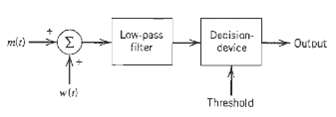Consider a baseband M-ary system using M discrete amplitude levels. The receiver model is as shown in
Question:
Consider a baseband M-ary system using M discrete amplitude levels. The receiver model is as shown in Figure, the operation of which is governed by the following assumptions;
(a) The signal component in the received wave is m (t) = ? n a n?sin (t/T ? n) where if 1/T is the signaling rate in bauds.
(b) The amplitude levels are an, +A/2, ?3A/2... ? (M ? l) A/2 if M is even, and an, = 0, ?A,..., ?(M -1)A/2 if M is odd
(c) The M levels are equiprobable, and the symbols transmitted in adjacent rime slots are statistically independent.
(d) The channel noise w (t) is white and Gaussian with zero mean and power spectral density N0/2.
(e) The low-pass filter is ideal with bandwidth B = 1/2T.
(f) The threshold levels used in the decision device are 0, ?A... ? (M ? 2) A/2 if M is even and tA/2, ?3A/2... ? (M ? 2) A/2 if M is odd, the average probability of symbol error in this system is defined by Pe = (1 ? 1/M) erfc (A/2?2?, where ? is the standard deviation of the noise at the input of the decision device. Demonstrate the validity of this general formula by determining Pe for the following three cases: M ? 2, 3, 4.

Step by Step Answer:






